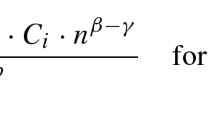Abstract
We consider multitype Markovian branching processes subject to catastrophes which kill random numbers of living individuals at random epochs. It is well known that the criteria for the extinction of such a process is related to the conditional growth rate of the population, given the history of the process of catastrophes, and that it is usually hard to evaluate. We give a simple characterization in the case where all individuals have the same probability of surviving a catastrophe, and we determine upper and lower bounds in the case where survival depends on the type of individual. The upper bound appears to be often much tighter than the lower bound.
Access this chapter
Tax calculation will be finalised at checkout
Purchases are for personal use only
Similar content being viewed by others
References
Andersen, A.T., Neuts, M.F., Nielsen, B.F.: On the time reversal of Markovian arrival processes. Stoch. Models 20, 237–260 (2004)
Asmussen, S., Koole, G.: Marked point processes as limits of Markovian arrival streams. J. Appl. Probab. 30, 365–372 (1993)
Asmussen, S., Ramaswami, V.: Probabilistic interpretations of some duality results for the matrix paradigms in queueing theory. Comm. Stat. Stoch. Models 6, 715–733 (1990)
Athreya, K., Karlin, S.: On branching processes with random environments, i: Extinction probabilities. Ann. Math. Stat. 5, 1499–1520 (1971)
Athreya, K.B., Ney, P.E.: Branching Processes. Springer, New York (1972)
Bean, N.G., Kontoleon, N., Taylor, P.G.: Markovian trees: properties and algorithms. Ann. Oper. Res. 160, 31–50 (2008)
Berman, A., Plemmons, R.J.: In: Nonnegative Matrices in the Mathematical Sciences. Classics in Applied Mathematics. SIAM, Philadelphia (1994)
Caswell, H.: Applications of Markov chains in demography. In: Langville, A.N., Stewart, W.J. (eds.) MAM 2006: Markov Anniversary Meeting, pp. 319–334. Boson Press, Raleigh (2006)
Fiedler, M., Plák, V.: On matrices with non-positive off-diagonal elements and positive principal minor. Czech. Math. J. 12(3), 382–400 (1962)
Furstenberg, H., Kesten, H.: Products of random matrices. Ann. Math. Stat. 31, 457–469 (1960)
Gharavi, R., Anantharam, V.: An upper bound for the largest Lyapunov exponent of a Markovian random matrix product of nonnegative matrices. Theor. Comp. Sci. 332, 543–557 (2005)
Golub, G.H., Van Loan, C.F.: Matrix Computations, 3rd edn. Johns Hopkins University Press, Baltimore (1996)
Harris, T.: The Theory of Branching Processes. Dover, New York (1963)
Key, E.: Computable examples of the maximal Lyapunov exponent. Probab. Theor. Relat. Fields 75, 97–107 (1987)
Key, E.: Lower bounds for the maximal Lyapunov exponent. J. Theor. Probab. 3(3), 477–488 (1987)
Kingman, J.F.C.: Subadditive ergodic theory. Ann. Probab. 1, 883–909 (1973)
Lima, R., Rahibe, M.: Exact Lyapunov exponent for infinite products of random matrices. J. Phys. A Math. Gen. 27, 3427–3437 (1994)
Moler, C., Van Loan, C.: Nineteen dubious ways to compute the exponential of a matrix, twenty-five years later. SIAM Rev. 45, 3–49 (2003)
Neuts, M.F.: A versatile Markovian point process. J. Appl. Probab. 16, 764–779 (1979)
Oseledec, V.I.: A multiplicative ergodic theorem: Lyapunov characteristic numbers for dynamical systems. Trans. Moscow Math. Soc. 19, 197–231 (1968)
Ross, S.M.: Stochastic Processes, 2nd edn. Wiley, New York (1996)
Smith, W., Wilkinson, W.: On branching processes in random environments. Ann. Math. Stat. 40, 814–827 (1969)
Tanny, D.: Limit theorems for branching processes in a random environment. Ann. Probab. 5, 100–116 (1977)
Tanny, D.: On multitype branching processes in a random environment. Adv. Appl. Probab. 13, 464–497 (1981)
Tsitsiklis, J., Blondel, V.: The Lyapunov exponent and joint spectral radius of pairs of matrices are hard – when not impossible – to compute and to approximate. Math. Control Signals Syst. 10, 31–40 (1997)
Watkins, J.C.: Limit theorems for products of random matrices. In: Cohen, J.E., Kesten, H., Newman, C.M. (eds.) Random Matrices and Their Applications. Contemporary Mathematics, vol. 50, pp. 5–22. American Mathematical Society, Providence (1986)
Acknowledgements
This work was subsidized by the ARC Grant AUWB-08/13–ULB 5 financed by the Ministère de la Communauté française de Belgique. The first author also gratefully acknowledges the support from the Fonds de la Recherche Scientifique (FRS-FNRS) and from the Australian Research Council, Grant No. DP110101663.
Author information
Authors and Affiliations
Corresponding author
Editor information
Editors and Affiliations
Rights and permissions
Copyright information
© 2013 Springer Science+Business Media New York
About this paper
Cite this paper
Hautphenne, S., Latouche, G., Nguyen, G.T. (2013). Markovian Trees Subject to Catastrophes: Would They Survive Forever?. In: Latouche, G., Ramaswami, V., Sethuraman, J., Sigman, K., Squillante, M., D. Yao, D. (eds) Matrix-Analytic Methods in Stochastic Models. Springer Proceedings in Mathematics & Statistics, vol 27. Springer, New York, NY. https://doi.org/10.1007/978-1-4614-4909-6_5
Download citation
DOI: https://doi.org/10.1007/978-1-4614-4909-6_5
Published:
Publisher Name: Springer, New York, NY
Print ISBN: 978-1-4614-4908-9
Online ISBN: 978-1-4614-4909-6
eBook Packages: Mathematics and StatisticsMathematics and Statistics (R0)




